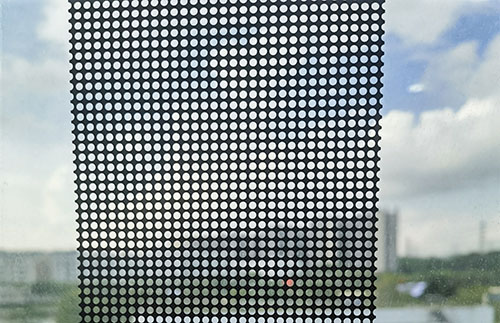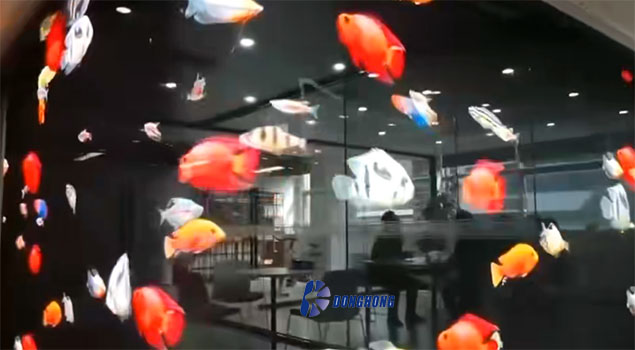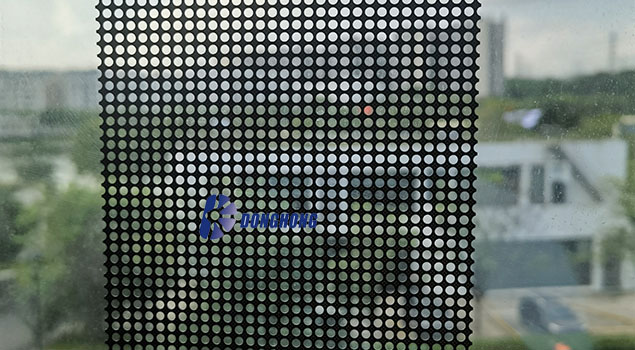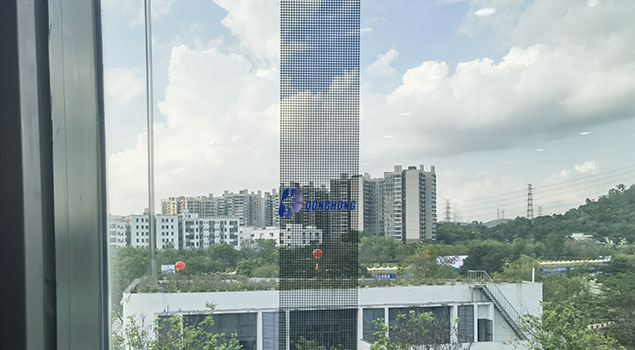P3.91 Holographic LED display
*Holographic LED Display *3.91-3.91mm pixel pitch *1000*125mm module *256*32mm module resolution

*Holographic LED Display *3.91-3.91mm pixel pitch *1000*125mm module *256*32mm module resolution
Features
The holographic LED display screen is a technology that combines LED technology with the principles of holographic imaging to produce three-dimensional holographic images or videos. It has several distinctive features:
1. Dreamy 3D holographic images: The holographic LED display screen uses LED arrays to create dreamy, floating three-dimensional holographic images that have significant depth and can be viewed from different angles.
2. Transparency: When the LEDs are turned off, the audience can see through the display screen. This feature allows holographic content to be integrated into the real-world environment without completely obstructing the view.
3. High brightness and contrast: The holographic LED display screen also boasts high brightness and contrast to ensure vivid and visually appealing holographic content, even in well-lit environments.
4. Wide viewing angles: Typically, holographic LED displays provide wide viewing angles, allowing audiences to view holographic images from different positions and angles without significantly compromising image quality.
Product specifications
| Model | P3.91 Holographic LED display |
| Pixel pitch | 3.91-3.91mm |
| Pixel density | 65536 dots/m² |
| Module size | 1000*125mm |
| Module resolution | 256*32mm |
| Module thickness | ≤3mm |
| Optimal viewing distance | 3~100m |
| Weight | 7kg/m² |
| Tansparency rate | ≤48% |
| Brightness | ≤4500cd/m² |
| Refresh frequency | 3840 Hz |
| Scan mode | Static |
| System | Nova/Mooncell |
| Max power/㎡ | ≤800W/㎡ |
| Average power/㎡ | ≤360W/㎡ |
| Installation | Mounting/Lifting |
| Protection level | IP23 |
| Max viewing angle | 160° |
| Power supply voltage | 3.8~5V |
| Working temperature | -20~55°C |
| Storage temperature | -25~90°C |
| Humidity range | 10%~90% |
| Storage humidity range | 20%~65% |
| Lifetime | >100000 hours |
Advantages
1. Powerful visual appeal: The unique visual effects of holographic LED display screens possess powerful visual appeal, making them highly suitable for applications in marketing, advertising, and entertainment industries, among others.
2. Interactivity and engagement: Holographic LED display screens can interact with audiences through gesture recognition or touch interaction technology, greatly enhancing user engagement.
3. Versatility: These display screens can be widely used in various settings, including retail stores, exhibition halls, museums, and various large-scale event venues. They can showcase products and other information with unique visual effects.
4. Scalability: The size of holographic LED display screens can be adjusted to accommodate different spatial requirements, ranging from small installations to large display screens.
Holographic LED display screens offer an innovative and engaging way to present content, with their ability to create mesmerizing 3D holographic images and videos while providing transparency, high brightness, wide viewing angles, and interactive features.
Application
The holographic LED display screen finds its primary applications in commercial advertising, product and information showcasing, and high-impact visual experience requirements in entertainment activities.
1. Advertising and Marketing
Holographic LED screens are commonly used in advertising and marketing activities to create attention-grabbing immersive experiences. By displaying visually impactful product or brand imagery through holographic LED screens, they can attract more attention and effectively promote products while enhancing brand awareness.
2. Retail and Exhibitions
In retail environments and large exhibition venues, holographic LED screens are often utilized to showcase products, demonstrate functionality, or provide interactive experiences. Creating virtual product displays, 3D models, or animations through holographic LED screens can significantly enhance promotional effects.
3. Entertainment Performances and Large-Scale Events
These screens are frequently employed in live entertainment performances and large-scale events to project performers' holographic images, creating a 3D visual effect that immerses the audience in a more realistic visual experience, thereby enhancing the overall impact and atmosphere of entertainment performances and events.
4. Museums and Galleries
Museums and art galleries also make use of holographic LED screens to display holographic 3D images, creating more experiential interactive exhibition effects, typically featuring educational or storytelling content. The unique effects of holographic 3D images can bring a sense of reality to historical events, artifacts, or artworks, integrating them into real-life experiences.
5. Education and Training
Holographic LED screens are commonly utilized in educational and training institutions, particularly in fields such as medical training, architecture, or engineering, to showcase 3D models and virtual environments, providing students with enhanced visual experiences.
6. Hospitality and Tourism Industry
In the hospitality and tourism industry, holographic LED displays are used to showcase captivating multimedia information, such as highlights of tourist destinations, route information, and virtual tours of attractions, to attract more foot traffic and increase tourism and accommodation revenue.
7. Product Launches and Demonstrations
Holographic LED screens are employed in product launches and demonstrations to create unforgettable and impactful visual experiences. They can display 3D product renderings, animations, or interactive content to help convey the functionality and advantages of products or concepts.
These are some of the most common applications of holographic LED screens. Due to their versatility and powerful visual impact, holographic LED display screens can be widely applied in various settings that require high visual impact to enhance the on-site effects of activities.


